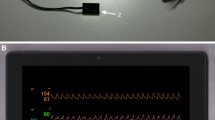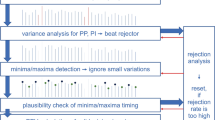Abstract
Objective. The purpose of this study was to estimate the accuracy, bias, and frequency response of continuous blood pressure monitoring using finger photoplethysmography in children.Methods. To compare arterial blood pressure measured using the Finapres device with simultaneously measured intraarterial blood pressure we studied 27 randomly selected postoperative pediatric patients who were receiving a variety of inotropic and vasoactive agents at a cardiac intensive care unit in university-affiliated pediatric hospital.Results. Sixty-two of 66 attempts (94%) to obtain a noninvasive blood pressure measurement were successful. A total of 37,351 paired blood pressure measurements from 53 records were compared, revealing a measurement bias of −18.6 mm Hg for systolic blood pressure and −13.4 mm Hg for diastolic blood pressure. The measurement bias increased proportionately to blood pressure, with systolic and diastolic gains between the noninvasive and intraarterial techniques of 0.86 and 0.75 mm Hg/mm Hg, respectively. The variation bias during each recording epoch, as measured by standard deviation of bias, was low (mean σsystolic=2.9 mm Hg; mean σdiastolic=2.0 mm Hg). The frequency response between the intraarterial and noninvasive pressure waveforms was flat to 10 Hz and approximately equal to 1.Conclusions. Substantial measurement bias exists between this noninvasive blood pressure measurement technique and intraarterial blood pressure. Measurements of the intrapatient variability and frequency response analysis suggest that the noninvasive technique accurately tracks intraarterial blood pressure over the short term. This technique may have useful applications in settings where intraarterial monitoring is undesirable or unobtainable.
Résumé
Objectifs. Le but de cette étude est d'estimer la précision, l'erreur, et la réponse en fréquence du monitorage continu de la pression artérielle chez les enfants à l'aide d'une méthode de photopléthysmographie au doigt.Méthodes. Pour comparer la mesure de pression artérielle par le procédé Finapres avec la mesure simultanée intra-artérielle, nous avons étudié en post-opératoire 27 patients pédiatriques non sélectionnés, qui ont reçu une variété d'agents inotropes et vaso-actifs dans une unité de soins intensifs cardiologiques d'une hôpital universitaire.Résultats. Soixante-deux des 66 tentatives (94%) d'obtention d'un signal de pression artérielle non-invasif furent couronnées de succès. Un total de 37 351 paires de mesures de pression artérielle en provenance de 53 enregistrements ont été comparées, révélant une erreur de mesure de −18,6 mmHg pour la pression artérielle systolique et de −13,4 mmHg pour la pression artérielle diastolique. L'erreur de mesure augmentait proportionnellement avec la pression artérielle, avec des pentes de 0,86 et 0,75 mmHg/mmHg, respectivement pour la pression artérielle systolique et pour la pression artérielle diastolique. La variation de l'erreur durant chaque période d'enregistrement, mesurée par l'écart-type de l'erreur, était faible (2,9 mmHg pour les mesures systoliques et 2,0 mmHg pour les mesures diastoliques). La réponse en fréquence entre les ondes de pression intraartérielles et non-invasives était plate à 10Hz et approximativement égal à 1.Conclusions. Une erreur de mesure non négligeable existe entre cette techniques de mesure non-invasive de la pression artérielle et la mesure intra-artérielle. Les mesures de la variabilité intra-patient et de l'analyse de réponse en fréquence suggèrent que la technique non-invasive indique précisément la tendance de pression artérielle à court terme. Cette technique peut avoir des applications utiles dans des environnements où le monitorage intraartériel est à éviter ou impossible à obtenir.
Abstrakt
Zielsetzung. Ziel der Untersuchung war es, die Genauigkeit, Abweichung und die das Frequenzverhalten einer kontinuierlichen Blutdruckmessung mit Hilfe der Fingerplethysmographie bei Kindern zu bestimmen.Methodik. Um den mit Hilfe des Finipres® gemessenen arteriellen Blutdruck mit dem gleichzeitig gemessenen intraarteriellen Blutdruck zu vergleichen, wurden randomisiert, postoperativ 27 Kinder, die unterschiedlich inotrope und vasoaktive Medikamente auf der Herzintensivstation eines an die Universität angeschlossenen Kinderspitals erhielten, untersucht.Ergebnisse. 62 der insgesamt 66 durchgeführten nichtinvasiven Blutdruckmessungen (94%) waren erfolgreich. Insgesamt wurden 37351 gepaarte Blutdruckmessungen aus 53 Aufzeichnungen verglichen. Hierbei war einen Abweichung von −18.6 mmHg für den systolischen Blutdruck und −13.4 mmHg für den diastolischen Blutdruck nachweisbar. Diese Abweichung nahm proportional mit steigendem Blutdruck zu, wobei eine Differenz zwischen der nichtinvasiven und der intraarteriellen Messung im sowohl systolischen als auch der diastolischen Blutdruck von+0.86 mmHg respektive +0.75 mmHg bestand. Die Abweichung während jeder Messung war, was sich in der Standardabweichung der Messungen niederschläug, eher gering (mittlere σsystolisch=2.9 mmHg; mittlere σdiastolisch=2.0 mmHg). Das Frequenzverhalten zwischen der intraarteriellen und der nichtinvasiven Druckkurve war mit 10m Hz flach und kam dem Wert 1 nahe.Schlussfolgerung. Es besteht eine beträchtliche Abweichung zwischen der nichtinvasiven Blutdruckmessmethode und der intraarteriellen Bludruckmessung. Die vorgenommen Daten zur intraindividuellen Variabilität und dem Frequenzverhaltren lassen jedoch die Aussage zu, daß die nichtinvasive Technik ausreichend genau den intraarteriellen Blutdruck über einen kurzen Zeitverlauf widerspiegelt. Diese Technik ist in den Fällen nützlich, wo ein intraarterielles Monitoring nicht geünwscht wird oder nicht möglich ist.
Resumen
Objetivo. El objetivo de este estudio fue estimar la precisión, sesgo y respuesta de frecuencia de monitorización continua de presión sanguínea usando pletismografía digital en niños.Metodos. Con el fin de comparar la presión sanguínea arterial medida usando el dispositivo Finapres con la presión intraarterial medida simultáneamente, estudiamos 27 pacientes pediátricos postoperatorios no seleccionados, quienes estaban recibiendo una variedad de agentes inotropos y vasoactivos en una unidad de cuidados intensivos postoperatorios en un hospital pediátrico con afiliación universitaria.Resultados. Sesenta y dos de los 66 intentos (94%) de obtener señal de presión sanguínea no invasiva fueron exitosos. Se compararon en total 37351 mediciones pareadas de presión arterial a partir de 53 registros, revelando un sesgo de medición de 18.6 mm Hg para la presión arterial sistólica y de 13.4 mm Hg para la diastólica. El sesgo de la medición aumentó proporcionalmente al nivel de presión, siendo las ganancias sistólica y diastólica entre las técnicas intraarterial y no invasiva 0.86 and 0.75 mm Hg/mm Hg, respectivamente. La variación del sesgo durante cada época de registro, medida como la desviación standard del sesgo, fue baja (s media sistólica=2.9 mm Hg; s media diastólica=2.0 mm Hg). La respuesta de frecuencia entre las ondas de presión intraarterial y no invasiva fue plana hasta 10 Hz y aproximadamente igual a 1.Conclusiones. Existe un sesgo substancial entre esta medición no invasiva de presión sanguínea y la medición intraarterial. Las mediciones de variabilidad dentro de cada paciente y el análisis de la respuesta de frecuencia sugieren que la técnica no invasiva sigue bien a la presión intraarterial en el corto plazo. Esta técnica puede tener aplicaciones útiles en situaciones donde la monitorización intraarterial no es aconsejable o imposible de obtener.
Similar content being viewed by others
References
Boehmer RD. Continuous real-time noninvasive monitoring of blood pressure: Penaz methodology applied to the finger. J Clin Monit 1987;3:282–287
Settels JJ, Wesseling KH. FIN.A.PRESS: non-invasive finger arterial waveform registration. In: Orlebeke JF, Mulder G, van Doornen LJP, eds. Psychophysiology of cardiovascular control models: methods and data. New York: Plenum, 1985:267–283
Wesseling KH, Settels JJ, DeWit B. The measurement of continuous finger arterial pressure noninvasively in stationary subjects. In: Schmidt TH, Dembroski TM, Blumchen G, eds. Biological and psychological factors in cardiovascular disease. Berlin: Springer-Verlag, 1986:355–375
Wesseling KH. Finapres: continuous noninvasive finger arterial pressure based on the method of Penaz. In: Meyer-Sabellek W, Anlauf M, Gotzen R, Steinfeld L, eds. Blood pressure measurement. Darmstadt: Steinkopff Verlag, 1990:161–172
Dorlas JC, Nijboer JA, Butjin WT, et al. Effects of peripheral vasoconstriction on the blood pressure in the finger, measured continuously by a new noninvasive method (the Finapres). Anesthesiology 1985;62:342–345
East TD, Pace NL, Sorenson RM, East KA, Westenskow DR. Effect of peripheral vascular disease on accuracy of noninvasive, continuous blood pressure measurement from the finger (Finapres). Anesthesiology 1987;67:A186
Hom M, Johnson PW, Mulroy MF. Blood pressure response to an epinephrine test dose in beta-blocked patients. Anesthesiology 1987;67:A268
Parati G, Casadei R, Groppelli A, et al. Comparison of finger and intra-arterial blood pressure monitoring at rest and during laboratory testing. Hypertension 1989;13:647–655
Gibbs NC, Gardner RM. Techniques in critical care. Dynamics of invasive pressure monitoring systems: clinical and laboratory evaluation. Heart Lung 1991;17:43–51
Davis RF. Clinical comparison of automated auscultatory and osillometric and catheter-transducer measurements of arterial pressure. J Clin Monit 1985;1:114–119
Hunziker P. Accuracy and dynamic response of disposable pressure transducer-tubing systems. Can J Anaesth 1987;34:409–414
Shinozaki T, Deane RS, Mazuzan JE. The dynamic responses of liquid-filled catheter systems for direct measurements of blood pressure. Anesthesiology 1980;53:498–504
Siegel LC, Pearl RG. Pressure measurement artifact with analog-to-digital conversion. J Clin Monit 1990;6:318–321
Milnor WR. Hemodynamics, ed 2. Baltimore, MD: Williams & Wilkins, 1989
Brigham EO. The fast Fourier transform. New York: Prentice Hall, 1991
Blackman RB, Tukey JW. The measurement of power spectra from the point of view of communications engineering. New York: Dover, 1959
Saul JP, Berger RD, Albrecht P, et al. Transfer function analysis of the circulation: unique insights into cardiovascular regulation. Am J Physiol 1991;261:H1231-H1245
Oppenheim AV, Willsky AS, Young AT. Signals and systems. London: Prentice-Hall, 1983
Gallagher JD, Moore RA, McNicholas KW, Jose AB. Comparison of radial and femoral arterial blood pressures in children after cardiopulmonary bypass. J Clin Monit 1985;1:168–171
Imholz BPM, Wieling W, Langewouters GJ, van Montfrans GA. Continuous finger arterial pressure: utility in the cardiovascular laboratory. Clin Autonom Res 1991;1:43–53
Molhoek GP, Wesseling KH, Settels JJ. Evaluation of the Penaz servoplethysmo-manometer for the continuous noninvasive measurement of finger blood pressure. Basic Res Cardiol 1984;79:598–609
van Egmond J, Hasenbos M, Crul JF. Invasive versus noninvasive measurement of arterial pressure. Br J Anaesth 1985;57:434–444
Epstein RH, Hufnagle S, Bartkowski RR. Comparative accuracies of a finger blood pressure monitor and an oscillometric blood pressure monitor. J Clin Monit 1991;7:161–167
Hunyor SN, Flynn JM, Cochineas C. Comparison of performance of various sphygmomanometers with intraarterial blood pressure readings. Br Med J 1978;2:159–162
Gould BA, Horrumy RS, Altman DG, et al. Indirect measurement of blood pressure during exercise testing can be misleading. Br Heart J 1985;53:611–615
Davis GJ, Geddes LA. Auscultatory mean blood pressure. J Clin Monit 1990;6:261–265
Gorback MS, Quill TJ, Lavine ML. The relative accuracies of two automated noninvasive arterial pressure measurement devices. J Clin Monit 1991;7:13–22
Epstein RH, Kaplan S, Leighton BL, et al. Evaluation of a continuous noninvasive blood pressure monitor in obstetric patients undergoing spinal anesthesia. J Clin Monit 1989;5:157–163
Hipkins SF, Rutten AJ, Runciman AJ. Laboratory investigations: experimental analysis of catheter-manometer systems in vitro and in vivo. Anesthesiology 1989;71:893–906
Bland JM, Altman DG. Statistical methods for assessing agreement between two methods of clinical measurement. Lancet 1986;i:307–310
Rutten AJ, Ilsley AH, Skowronski GA, Runciman AJ. A comparative study of the measurement of mean arterial blood pressure using automatic oscillometers, arterial cannulation and auscultation. Anaesth Intensive Care 1986;14:58–65
Runciman AJ, Rutten AJ, Ilsley AH. An evaluation of blood pressure measurement. Anaesth Intensive Care 1981;9:314–325
Author information
Authors and Affiliations
Additional information
Dr Triedman is supported in part by an NIH Training Grant and a Physician-Investigator Fellowship from the Massachusetts Affiliate of the American Heart Association. Dr Saul is supported by a grant from the Whitaker Foundation.
Rights and permissions
About this article
Cite this article
Triedman, J.K., Saul, J.P. Comparison of intraarterial with continuous noninvasive blood pressure measurement in postoperative pediatric patients. J Clin Monitor Comput 10, 11–20 (1994). https://doi.org/10.1007/BF01651461
Received:
Revised:
Accepted:
Issue Date:
DOI: https://doi.org/10.1007/BF01651461




